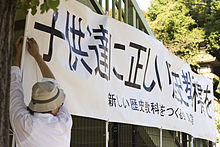Association for the creation of new history textbooks
The association for the creation of new history textbooks ( Japanese 新 し い 歴 史 教科書 を つ く る 会 Atarashii rekishi kyōkasho o tsukuru kai , short: Tsukurukai ) was founded in 1996 by Kobayashi Yoshinori and is the successor of the "Association for the liberal" former view of history and research "( Promotion of a liberal view of history “ 自由主義 史 観 研究 会Jiyūshugi Shikankenkyū Kai ).
The aim of the historical revisionist association is to promote national pride, national consciousness and patriotism in the Japanese youth by changing the perspective of historiography. He is directed against the prevailing scientific and war-critical historiography, which is described as "masochistic" ( 自虐 jigyaku ) and Marxist, as this focuses too much on the darker sides of Japanese history. Through its war-glorifying writings and relativizing media campaigns, the association poses a problem for the reconciliation of Japan with China and South Korea. The association receives support from legal political (especially LDP ) and economic circles. The association also participates in debates on the repeal of the war waiver article of the Japanese constitution .
In 1999 the number of members exceeded 10,000 for the first time.
Historiography
In the history of the Tsukurukai , Japan is represented as a solid unit of people, nation and country, which has existed continuously since ancient times. The positive aspects of Japanese history are particularly emphasized. The achievements of Japan are compared with those of the world, especially those of the West and its Asian neighbors. In this comparison the position of Japan is emphasized as at least equal to the West and clearly superior to its Asian neighbors. It even shows a certain contempt for the neighbors, who are presented as underdeveloped and inferior.
The Pacific War, and with it the Second World War , is portrayed as a glorious war of liberation that Japan waged to protect Asia from the imperialism of the West (see Greater East Asian Prosperity Sphere ). Japanese imperialism and colonialism are completely ignored. In addition, the anti-Japanese resistance, the negative consequences of the war and Japanese war crimes - such as the Nanjing massacre , unit 731 or the " comfort women " - are not mentioned. Rather, war is legitimized as an acceptable means of resolving international conflicts.
Publications
- Atarashii rekishi kyōkasho ( 新 し い 歴 史 教科書 , “New History Textbook”), Fusōsha, 2001, ISBN 4-594-03155-2
- Atarashii kōmin kyōkasho ( 新 し い 公民 教科書 , "New Citizen Textbook"), Fusōsha, 2001, ISBN 4-594-03156-0
criticism
Both Atarashii rekishi kyōkasho and Atarashii kōmin kyōkasho were officially approved for school instruction by the Japanese Ministry of Culture in 2001 . Because of the flawedness and nationalism of the books, the admission caused great surprise and outrage in Japanese society, in academic circles and in Japan's neighboring states South Korea and China. The books were criticized, among other things, that they contained many errors in content, presented a one-sided, arbitrary or distorted presentation of history, tried to back up Japanese myths with facts and addressed current political topics, i.e. were completely unsuitable for school lessons. The approval was followed by public protests against the use of the books in schools and an association to point out the mistakes of Atarashii kōmin kyōkasho was founded.
According to a survey from August 2001, no state school used the Atarashii rekishii kyōkasho , but only a few private schools, with which the book was used by a total of 0.03% of students. According to the Ministry of Education, it was then around 0.1% in 2004 and it was also used in public schools in the school districts of Matsuyama , Imabari and Uwajima . By June 2004 it sold 600,000 copies, exceptionally well for a textbook.
See also
literature
- Sven Saaler: Politics, Memory and Public Opinion. The Historic Textbook Controversy and Japanese Society . Iudicum, Munich 2005, ISBN 3-89129-849-8 , Chapter 1. Historical Revisionism in Contemporary Japan.
Web links
- official website (Japanese)
Individual evidence
- ^ Kathleen Woods Masalski: Examining the Japanese History Textbook Controversies. In: Stanford Program on International and Cross-Cultural Education. November 2001, accessed October 21, 2012 .
- ↑ Only 0.03% of junior high students to use disputed textbook . Kyodo News, Aug 16, 2001
- ↑ 新 し い 歴 史 教科書 < 教育 の 現場 か ら: 04 参 院 選 (上) > . Asashi Shimbun-sha, July 3, 2004, accessed October 21, 2012 (Japanese).
